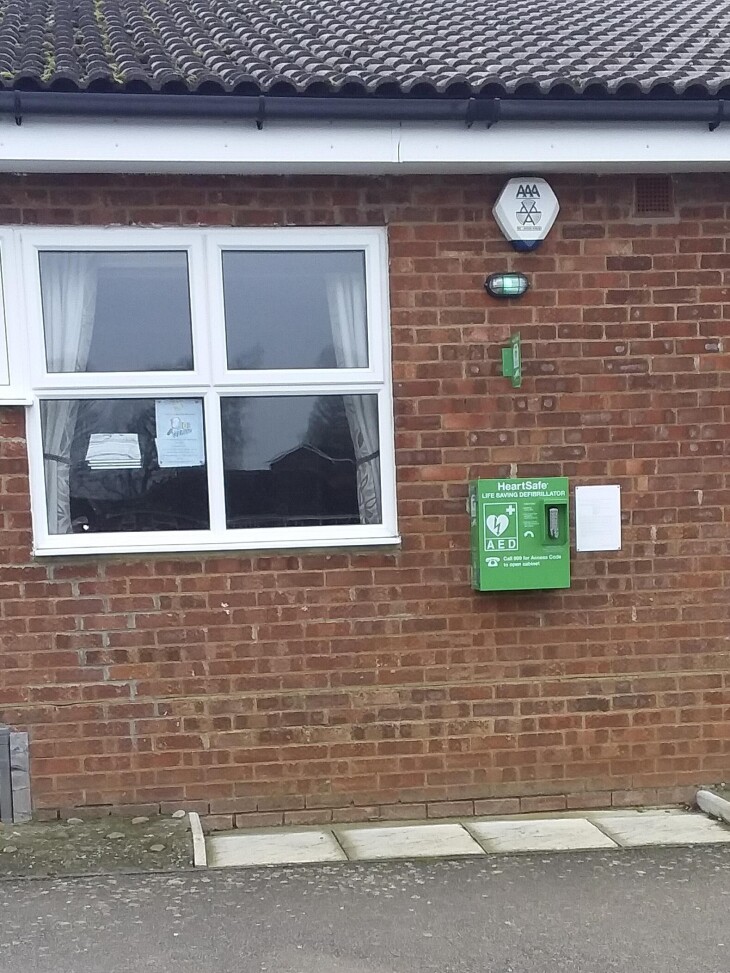Defibrillators can Save Lives
Published on

Don’t Forget there is a life Saving Defibrillator donated to the community by Southcott Village Residents Association, on the front wall of the Community Centre, Opposite Tesco Express
Don’t be afraid of using a defibrillator, YOU could Save a LIFE! The device will talk you through the process step by step.
4 steps to take if someone is having a Cardiac Arrest
Cardiac arrests can happen to anyone, at any time. The following steps give someone the best chance of survival. If you come across someone in cardiac arrest:
1. Call 999
2. Start CPR
3. Ask someone to bring the defibrillator from the front of the SVRA Club
4. Turn on the defibrillator and follow its instructions
A defibrillator is a device that gives a high energy electric shock to the heart of someone who is in cardiac arrest
If you come across someone who is unconscious, unresponsive, not breathing or not breathing normally, they’re in cardiac arrest. The most important thing is to call 999 and start CPR to keep the blood flowing to the brain and around the body. After a cardiac arrest, every minute without CPR and defibrillation reduces someone's chance of survival by 10 per cent.
If you're on your own, don't interrupt the CPR to go and get a defibrillator. If it's possible, send someone else to collect it.
To use a defibrillator, follow these simple steps:
Step 1: Turn the defibrillator on by pressing the green button and follow its instructions.
Step 2: Peel off the sticky pads and attach them to the patient’s skin, one on each side of the chest, as shown in the picture on the defibrillator.
Step 3: Once the pads have been attached, stop CPR and don’t touch the patient. The defibrillator will then analyse the patient’s heart rhythm.
Step 4: The defibrillator will assess whether a shock is needed and if so, it will tell you to press the shock button. An automatic defibrillator will shock the patient without prompt. Do not touch the patient while they are being shocked.
Step 5: The defibrillator will tell you when the shock has been delivered and whether you need to continue CPR.
Step 6: Continue with chest compressions and rescue breaths until the patient shows signs of life or the defibrillator tells you to stop so it can analyse the heartbeat again.
The link below is a video demonstration.
youtu.be/YbjcCjSNvUY
Don’t be afraid of using a defibrillator, YOU could Save a LIFE! The device will talk you through the process step by step.
4 steps to take if someone is having a Cardiac Arrest
Cardiac arrests can happen to anyone, at any time. The following steps give someone the best chance of survival. If you come across someone in cardiac arrest:
1. Call 999
2. Start CPR
3. Ask someone to bring the defibrillator from the front of the SVRA Club
4. Turn on the defibrillator and follow its instructions
A defibrillator is a device that gives a high energy electric shock to the heart of someone who is in cardiac arrest
If you come across someone who is unconscious, unresponsive, not breathing or not breathing normally, they’re in cardiac arrest. The most important thing is to call 999 and start CPR to keep the blood flowing to the brain and around the body. After a cardiac arrest, every minute without CPR and defibrillation reduces someone's chance of survival by 10 per cent.
If you're on your own, don't interrupt the CPR to go and get a defibrillator. If it's possible, send someone else to collect it.
To use a defibrillator, follow these simple steps:
Step 1: Turn the defibrillator on by pressing the green button and follow its instructions.
Step 2: Peel off the sticky pads and attach them to the patient’s skin, one on each side of the chest, as shown in the picture on the defibrillator.
Step 3: Once the pads have been attached, stop CPR and don’t touch the patient. The defibrillator will then analyse the patient’s heart rhythm.
Step 4: The defibrillator will assess whether a shock is needed and if so, it will tell you to press the shock button. An automatic defibrillator will shock the patient without prompt. Do not touch the patient while they are being shocked.
Step 5: The defibrillator will tell you when the shock has been delivered and whether you need to continue CPR.
Step 6: Continue with chest compressions and rescue breaths until the patient shows signs of life or the defibrillator tells you to stop so it can analyse the heartbeat again.
The link below is a video demonstration.
youtu.be/YbjcCjSNvUY